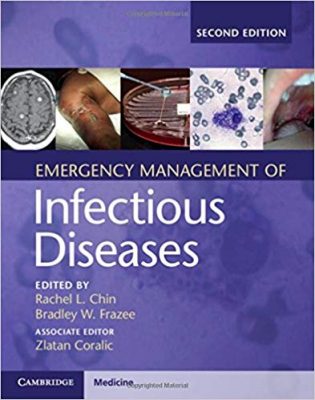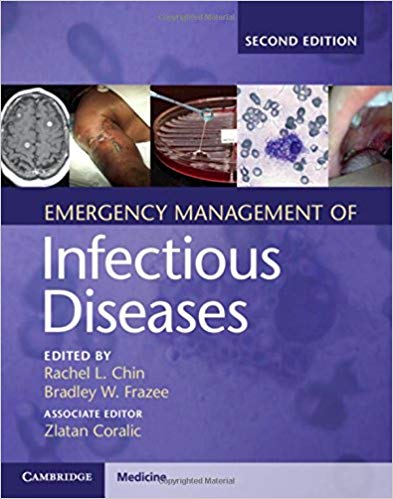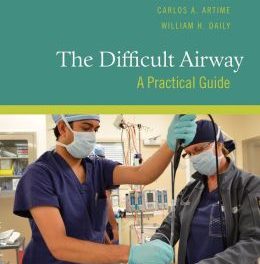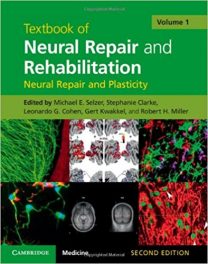 Editors: Rachel L. Chin and Bradley W. Frazee
Editors: Rachel L. Chin and Bradley W. Frazee
Associate Editor: Zlatan Coralic
Publisher: Cambridge University Press – 627 pages
Book Review by: Sonu Chandiram
This second edition of the book published in 2018 is an update to the first edition published in 2008, and provides comprehensive coverage of the very many ailments, conditions, diseases, and disorders faced by emergency medicine physicians in hospitals and clinics all over the United States on a daily basis. This book covers in its 600+ pages, the entire gamut of bacterial, fungal, parasitic, and viral infections.
The editors and authors discuss the epidemiology, microbiology, and pathophysiology of each disease at the beginning of each chapter, providing ample visual images, with captions.
Ninety-seven specialists in various types of infectious diseases from all around the U.S. authored the 78 chapters of this book.
We name the individual chapters below to provide you an overview of its contents, since the chapters are not grouped together or divided into parts or sections. This will also enable you the reader, to easily check which topics are covered or not covered in this book.
- Infective Endocarditis
- Pericarditis and Myocarditis
- Cardiac Implantable Electronic Device Infections
- Altered Mental Status in HIV-infected Patients
- Botulism
- Fever and Focal Cerebral Dysfunction
- Infections Affecting the Spinal Cord
- Meningitis
- Rabies
- Tetanus
- West Nile Encephalitis Virus
- Bacterial Skin and Soft Tissue Infections
- Ectoparasites
- Fever and Rash in Adults
- Otitis Externa
- Otitis Media
- Sinusitis
- Supraglottis (Epiglottis)
- Parotitis
- Pharyngitis and Perotonsillar Abcess
- Deep Neck Space Infections
- Dental and Odontogenic Infections
- Infectious Biliary Diseases: Cholecystitis and Cholangitis
- Viral Hepatitis
- Peritonitis
- Acute Infectious Diarrhea
- Diarrhea in HIV-Infected Patients
- Clostridium Difficile Infection
- Male Genitourinary Infections
- Non-Ulcerative Sexually Transmitted Diseases
- Ulcerative Sexually Transmitted Diseases
- Vulvovaginitis
- Adult Septic Arthritis
- Diabetic Foot Infections
- Hand Infections: Fight Bite, Tenosynovitis, Felon and Paronchia
- Open Fractures
- Osteomyelitis
- Plantar Puncture Wounds
- Prosthetic Joint Infections
- Spine Infections
- Conjunctival and Corneal Infections
- Periocular Infections
- Infections of the Uvea, Vitreous, and Retina
- Community-Acquired Pneumonia
- HIV-Associated Respiratory Infections
- Influenza
- Tuberculosis
- Lower Urinary Tract Infection in Adults
- Pyelonephritis in Adults
- Fever in the Newborn
- The Febrile Child
- Fever and Rash in the Pediatric Population
- Pediatric Orthopedic Infections
- Pediatric Respiratory Infections
- Pediatric Urinary Tract Infections
- Bites (Dogs, Cats, Rodents, Lagomorphs)
- Blood or Body Fluid Exposure Management and Post-Exposure Prophylaxis for Hepatitis B and HIV
- Fever in Pregnancy
- Postpartum and Post-Abortion Infections
- Fever in the Returning Traveler
- Infectious Complications of Injection Drug Use
- Infections in Oncology Patients
- Post-Operative Infections
- The Febrile Post-Transplant Patient
- Sepsis
- Infections in Sickle Cell Disease
- Anthrax
- Plague
- Smallpox
- Tularemia
- Hantavirus
- Ebola Virus Disease
- Zika Virus
- Zoonotic Influenza (Novel Influenza A, Including Avian and Swine Influenza A Virus Infections
- Methicillin-Resistant Staphylcoccus Aureus (MRSA)
- Enterocci
- Extended-Spectrum Beta-Lactamase
- Antimicrobial Overview
To give you an idea of how each chapter provides coverage. Let us take a look at the outline of chapter 8 – Meningitis:
Outline
Introduction
Epidemiology
Microbiology
- Acute Bacterial Meningitis
- Aseptic Meningitis an Viral Meningitis
Clinical Features
Differential Diagnosis
Laboratory and Radiographic Findings
- CSF Studies
- Interpreting the CSF
Treatment
- Steroids
Chronic Meningitis, Fungal Meningitis, and Unusual Pathogens
- Fungal Meningitis
- Tuberculous Meningitis
- Syphilis
- Parasitic Meningitis
Special Considerations
- Shunt Infections
- Skull Fractures, Penetrating Trauma, or History of Neurosurgical Procedure
- Immunocompromised Patients
Complications and Admission Criteria
Infection Control
Pearls and Pitfalls
References
Additional Readings
This is an ideal textbook on infectious diseases, and very comprehensive. The detailed coverage in each chapter of all the important aspects of each infectious disease and variations is ideal for medical students, residents, as well as established practitioners.
Editors:
Rachel L. Chin is Professor of Emergency Medicine in the Department of Emergency Medicine at the University of California, San Francisco School of Medicine, and the Zuckerberg San Francisco General Hospital and Trauma Center.
Bradley W. Frazee is with the Department of Emergency Medicine at the Alameda Health System – Highland Hospital in Oakland, California; and is Clinical Professor of Emergency System at the University of California, San Francisco School of Medicine in San Francisco, California.
Associate Editor:
Zlatan Coralic is Assistant Clinical Professor of Emergency Medicine, and Emergency Medicine Clinical Pharmacist at the University of California, San Francisco School of Medicine in San Francisco, California.






